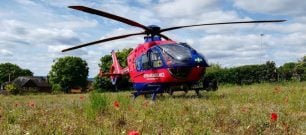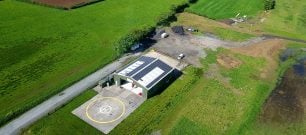
After nearly three years in design and development, Devon Air Ambulance has formally taken ownership of its new Airbus H145 helicopter at the Airbus Helicopter UK base at Oxford airport.
A pilot’s perspective
On Friday 5 June, after nearly three years in design and development, Devon Air Ambulance formally took ownership of its new Airbus H145 helicopter at the Airbus Helicopter UK base at Oxford airport.
This event marked a significant milestone in the evolution of Devon Air Ambulance (DAA) and was the culmination not only of a large financial commitment, but also a significant time investment. The Flight Operations and Patient Services teams have spent many months carefully planning what type of aircraft and the internal fit-out DAA require to meet our current and future HEMS operations.
Over the next series of blogs, we want to take an in-depth look at the H145 helicopter to see how its new-generation aviation systems, coupled with our bespoke interior layout will benefit our service and our patients.
In the first of these blogs we caught up with Pilot Craig Bisset to explore some of the characteristics of the H145 and how these qualities, alongside the suite of advanced aviation management systems onboard, will help our pilots plan and deliver HEMS missions in Devon.
How does the new H145 helicopter differ from the EC135 aircr
Externally the H145 and EC135 look quite similar in that they both have the Devon Air Ambulance red and blue livery. When you take a closer look however it’s clear that H145 is a larger aircraft overall (particularly noticeable is the larger engine cowling above the cockpit). Having a larger airframe means that there is increased space and interior layout and we can use this to:
Have a larger medical compartment – which gives our clinicians better access to a patient and a better environment to carry out enhanced and critical care procedures. Starting with a ‘blank canvas’ we have worked with the Swiss company Bucher to design a medical layout, which uniquely includes two seats located alongside the stretcher giving clinicians access to the full length of the patient in flight.
Carry more medical equipment – over time we have increasingly seen the need to carry more clinical equipment as we are able to deliver a wider range of medical interventions to patients. As we expect that trend to continue, the additional space on the H145 gives us the extra storage capacity into the future. The introduction of LyoPlas as a treatment last year, or the more recent requirement to carry supplies of various PPE, illustrate how we need to build-in scope to increase the amount of medical equipment and kit we carry.
Carry more people – whilst the majority of our operations are carried out with two paramedics, in over 40% of our flights we now operate with two paramedics and a doctor onboard. As our crew composition has changed over the years, so space in the EC135 has become more cramped. The larger internal space of the H145 includes more seating and it can accommodate up to four people with a patient. Now, even when operating with three clinicians onboard, we have the scope to carry a patient’s parent or guardian, or we have room for a trainee clinician or pilot (which is important as we continue to support the development of future staff).
The H145: more power and more payload but still nimble
Whilst there are clearly many advantages to having a larger more spacious helicopter, we have been very conscious of the need to balance those benefits with our ability to operate this new aircraft into what we know can be quite challenging environments in Devon.
Larger than the EC135, the H145 is also a more powerful aircraft and offers a payload increase of over 200kg, which is clearly important if we need to carry more medical equipment and potentially more people onboard. The increased power provided by the two Safran Turbomeca Arriel 2E engines (offering 1072 shp) also ensures that, even when flying with these heavier loads, we can still operate into more difficult landing sites.
The H145 delivers a package of new generation aviation manag
In 2008 DAA bought its first EC135 helicopter (registered ‘G-DVAA’) (the aircraft being replaced by the new H145) and in 2013 its second EC135 helicopter (‘G-DAAN’) and since then we have seen huge advances in aviation technology (as a comparison, consider how our mobile phones or TV’s have advanced in the past 7 years). It’s not surprising therefore that the aviation technology included in the H145 (‘G-DAAS’) is, in some respects, a world away from our older EC135 aircraft.
The ‘operating brain’ behind the H145 is Helionix, “an avionics system designed by Airbus Helicopters to offer increased mission flexibility to operators and to positively impact operational safety”. In effect Helionix co-ordinates and manages all the aircrafts operating systems including the engines, safety systems, navigation, communications and mapping systems. A fundamental part of Helionix is the digital interface which communicates all of this operational information and live data with the aim of delivering the right information at the right time and in the right way for the pilot and crew.
One example of the advanced technology incorporated in the Helionix system is the Helicopter Terrain Awareness and Warning System (HTAWS). HTAWS is a computer-based geographical mapping system that provides the crew with alerts (both aural and visual) of potential obstacles and takes into account crew recognition and reaction times. For example, it will warn the pilot if and where there are notable changes in terrain such as when flying over hilly ground on Exmoor or Dartmoor. HTAWS is one example of how the Helionix system helps to enhance pilot situational awareness, which is a very important means by which an individual perceives their environment and understands how different objects can affect their current status and projected future context (i.e. accounting for time and space). Having good situational awareness is therefore a really important factor in making effective decisions when operating an aircraft.
As a new modern aircraft there are a range of other benefits to the new H145 –we’re introducing air conditioning for the first time and an anti-vibration control system which will enhance the working environment for all onboard. There are also a range of well-thought out extras on the H145 such as a camera located on the tail of the aircraft which covers the skids – useful to check the skids are level when landing on soft ground and helpful for the pilot when checking how medical teams are managing when loading a patient through the rear doors.
A thorough pilot training programme
Since taking ownership of the new H145, Devon Air Ambulance pilots have been undertaking an intensive training programme with Airbus Helicopters UK in Oxfordshire. The three-week programme started with a week-long ground-school, where pilots learn about the theory side of operating the H145. While converting to a new helicopter type is a relatively well-worn path for most pilots it does present some challenges as there are inevitable differences between types – some major – and these all need to be thoroughly mastered before a number of tests are taken to ensure competency.
After ground school, the pilots carry out two weeks of ‘visual’ and ‘instrument’ flight training which culminates in both a flying skills test and a theory exam. The airborne element is completed prior to a Civil Aviation Authority licence submission and demonstrates to the examiner that the emergency procedures and manoeuvres learnt can be carried out competently. The theory exam is set to test knowledge of the aircraft systems and limitations taught during the first week of ground school.
The timeframe for the process to train and qualify our pilots will have been completed by the end of September as we clearly need to manage this training alongside still delivering the service 19 hours a day. In the meantime, G-DAAS has now been moved from the Airbus base in Oxford to its new home in Devon and our pilots are continuing their training, now also including day and night ‘line-training’ (the process of flying under supervision to gain more experience) over the skies of Devon. Keep a look out overhead in case it passes near you!
Over the coming months we will be rolling out our internal training programme to all the paramedics and doctors as we share our learning and development of operating the H145 throughout the Patient Services team. In the next blog, we will look at how we have designed the medial compartment fit out and the reasons why, plus all the training our clinicians will be undertaking as we work towards bringing the new H145 into service this Autumn.
Overview of the Airbus H145 technical specification:
| Overall length | 13.54m |
| Overall height | 3.98m |
| Overall width | 2.4m |
| Rotor diameter | 10.8m |
| Internal volume | 6.03m³ |
| Engines | 2 Safran Arriel 2E engines |
| Fuel capacity | 723kg |
| Max take off weight | 3,800kg |
| Cruise speed | 148mph |



